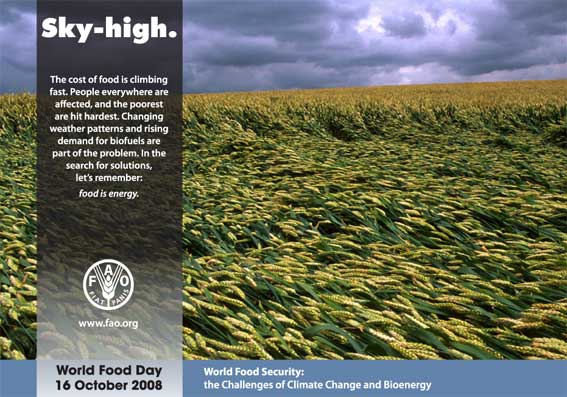Theme of World Food Day,2008
World Food Security, the Challenges of Climate Change and Bioenergy
Credits: FAO
Posted By: Dr Shuja ul Rehman
Climate change affects everyone. But the worst hit will be hundreds of millions of small-scale farmers, fishers and forest-dependent people who are already vulnerable and food insecure. By affecting the availability of land, water and biodiversity, and the price of food, the rising demand for biofuels produced from food crops also has an impact on the poor.
World Food Day provides an occasion to once again highlight the plight of 862 million undernourished people in the world. Most of them live in rural areas where their main source of income is the agricultural sector. Progress towards the World Food Summit goal of reducing their numbers by half by 2015 has already stalled. Global warming and the biofuel boom are now threatening to push the number of hungry even higher in the decades to come.
Adapting to climate change
Climate change will affect the suitability of land for different types of crops, livestock, fish and pasture. It will also have an impact on the health and productivity of forests, the incidence of pests and diseases, biodiversity and ecosystems. Changes in temperatures and precipitation as well as more frequent extreme weather are expected to result in crop and livestock production shortfalls and other asset losses, thereby threatening food production but also access, stability and utilization of food resources.
Many adaptation measures will focus on strengthening measures already in place, such as sustainable and ecological farming practices, early warning systems, systems to identify climate change “hot spots” and disaster risk management. Others will focus on rural investments to reduce the long-term effects of short-term climate variability on food security, through crop insurance and incentives that encourage farmers to adopt better agricultural and land use practices.
Agriculture should contribute to reducing greenhouse gas emissions through such measures as reduction of deforestation, improved forest conservation and management, better control of wildfires, agro-forestry for food or energy, soil carbon sequestration, restoring land through controlled grazing, improving nutrition for ruminant livestock like cattle, more efficient management of livestock waste including biogas recovery, and other strategies that conserve soil and water resources by improving their quality, availability and efficiency of use. The use of biofuels as a solution to reduce carbon emissions and to become more independent from fossil fuels has crucial implications for food security as well as for current and future land use .
Land
Climate change threatens to uproot many rural communities. For example, rising sea levels may force many communities in low-lying coastal areas and river deltas in developing countries to move to higher ground. Similarly, increasingly frequent droughts brought on by climate change may leave farmers and pastoralists who rely on rainfall to raise their crops and livestock in conflict over land and water. This displacement of people is likely to result in competition between migrants and established communities for access to land. Reconciling diverse land use needs presents daunting challenges for governments at all levels. In cases where land rights are informal and different customary land tenure systems coexist, governments will need to work closely with local communities to establish fair and equitable systems of land tenure and develop mechanisms for resolving disputes. For many displaced communities, it may be impossible to maintain their farming or pastoral traditions. Land tenure policies designed to facilitate resettlement will need to be incorporated into a broader programme that provides opportunities for the displaced to earn livelihoods outside the agricultural sector.
Water
As a consequence of climate change, farmers will face growing unpredictability and variability in water supplies and increasing frequency of droughts and floods. Hardest hit will be rainfed agriculture – which covers 96 percent of all cultivated land in sub-Saharan Africa, 87 percent in South America and 61 percent in Asia. In marginal semi-arid zones with prolonged dry seasons, the risk of crop failures will increase. Where stability of production cannot be assured, people will be forced to migrate.
But irrigation in large river basins and deltas are also at risk from a combination of reduced runoff, salinity (Indus), increased flooding and sea level rise (Nile, Ganges-Brahmaputra, Mekong, Yangtse), and urban and industrial pollution. These stresses on some of the prime productive land will reduce the agricultural output, biodiversity and the natural ability of ecosystems to recover – with possible negative impacts on millions of farmers and consumers across the world as food supply becomes progressively constrained. Areas projected to experience lower precipitation will need to improve water storage, management and productivity. Large irrigation schemes will needto adapt to changes in water supply regimes and support will be needed for small-scale, field-based water control measures.
Biodiversity
The 2005 Millennium Ecosystem Assessment estimates that by the end of this century, climate change will be the main cause of biodiversity loss. But as climate changes, the value of biodiversity for food and agriculture will increase. Genetic resources are the living material that local communities, researchers and breeders use to adapt food and agricultural production to changing needs. Maintaining and using this reservoir of genetic diversity will be the foundation for coping with climate change.
Transboundary pests and diseases
While there is clear evidence that climate change is altering the distribution of animal and plant pests and diseases, the full effects are difficult to predict. Changes in temperature, moisture and atmospheric gases can fuel growth and generation rates of plants, fungi and insects, altering the interactions between pests, their natural enemies and their hosts. Changes in land cover, such as deforestation or desertification, can make remaining plants and animals increasingly vulnerable to pests and diseases. New farming practices, different crops and animal breeds, and integrated pest management principles must be developed to help stem the spread of pests. Countries may need to consider the introduction of biological control agents or new pest- or disease-resistant crops and breeds.
Governments also need to strengthen national animal and plant health services as a top priority.
Fisheries and aquaculture
Impacts of climate change will affect fisheries- and aquaculture-dependent people as production and marketing costs increase, buying power and exports decrease and dangers from harsher weather conditions rise. Small fishing communities in some areas will face greater uncertainty as availability, access, stability and use of aquatic food and supplies diminish and as work opportunities dwindle. Now accounting for 45 percent of global seafood consumption, aquaculture production will continue rising to meet future demand. Here, climate change offers new opportunities. Production in warmer regions will likely increase because of better growth rates, a long growing season and the availability of new fish farming areas where it was once too cold. Therefore, aquaculture development opportunities will increase in particular in tropical and sub-tropical regions, such as in Africa and Latin America.
Managing the risk
Much can be done now and in the next few decades to lessen the worst effects of global warming. These measures include:
• developing climate and climate impact models that give a better understanding of how climate change may affect farming and forestry at a local level in order to be better prepared;
• diversifying livelihoods and adapting agricultural, fishing and forestry practices by encouraging better water management, soil conservation, resilient crops and trees;
• improving and expanding weather and climate forecasting;
• improving monitoring and early warning systems;
• developing disaster risk management.
To better adapt to climate change impacts:
• land use plans, food security programmes, fisheries and forestry policies must all be adjusted.
• cost/benefit analyses are needed to take account of climate change risks for irrigation or coastal protection.
• farmers’ best practices should be promoted through capacity building and networking.
• implementation of National Adaptation Programmes of Action on climate change needs to be supported.
• contingency plans need to cover new and evolving risk scenarios.
FAO hosted the High-Level Conference on World Food Security: the Challenges of Climate Change and Bioenergy from 3 to 5 June 2008. One hundred eighty-one (181) countries participated – 43 were represented by their Head of State or Government and 100 by high-level Ministers. Overall, 5 159 people attended – 1300 of them were journalists covering the event. The Summit has concluded with the adoption by acclamation of a Declaration on World Food Security. “It is essential to address the question of how to increase the resilience of present food production systems to challenges posed by climate change… We urge governments to assign appropriate priority to the agriculture, forestry and fisheries sectors, in order to create opportunities to enable the world’s smallholder farmers and fishers, including indigenous people, in particular vulnerable areas, to participate in, and benefit fromfinancial mechanisms and investment flows to support climate change adaptation, mitigation and technology development, transfer and dissemination… We call upon relevant inter-governmental organizations, including FAO, within their mandates and areas of expertise, with the involvement of national governments, partnerships, the private sector, and civil society, to foster a coherent, effective and results-oriented international dialogue on biofuels in the context of food security and sustainable development needs.”



hello,
congrate for taking this moral efforts towards world food issues we inspired with such type of programme feel moral duty we also organize this programme every year.
World Hunger Year co-founder Bill Ayers will be my guest on News Talk Online on Paltalk.com at 5 PM New York time today to talk about World Food Day.
Please go to my blog at http://www.garybaumgarten.com and click on the link to the show to talk to Ayers.
Thanks.
Its very good to see, that, someone at least is taking such steps for the development, I being a nutritionist want that food and nutrition should reach all people. and moreover I born on Worlds Food day too, so that makes me further more inclined towards this development.